January 2025
The global hexyl acetate market size surpassed USD 99.05 million in 2023 and is estimated to increase from USD 103.53 million in 2024 to approximately USD 161.08 million by 2034. It is projected to grow at a CAGR of 4.52% from 2024 to 2034.
The global hexyl acetate market size is projected to be worth around USD 161.08 million by 2034 from USD 103.53 million in 2024, at a CAGR of 4.52% from 2024 to 2034. The North America hexyl acetate market size reached USD 33.68 million in 2023. Hexyl acetate is a common aroma component found in cosmetic and personal care items. The hexyl acetate market is driven by rising demand for personal hygiene products like deodorants and perfumes.
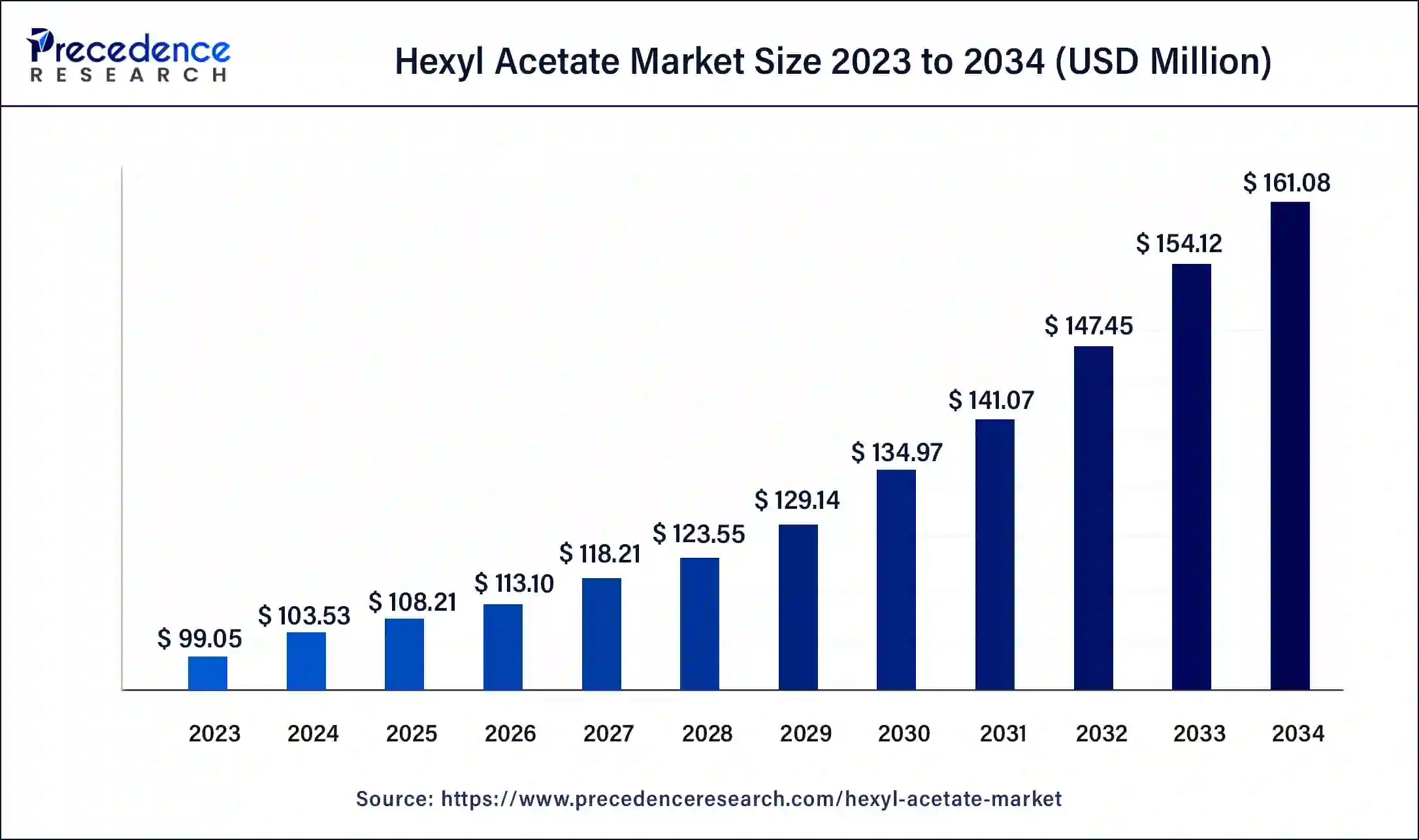
The U.S. hexyl acetate market size was exhibited at USD 25.26 million in 2023 and is projected to be worth around USD 41.96 million by 2034, poised to grow at a CAGR of 4.72% from 2024 to 2034.
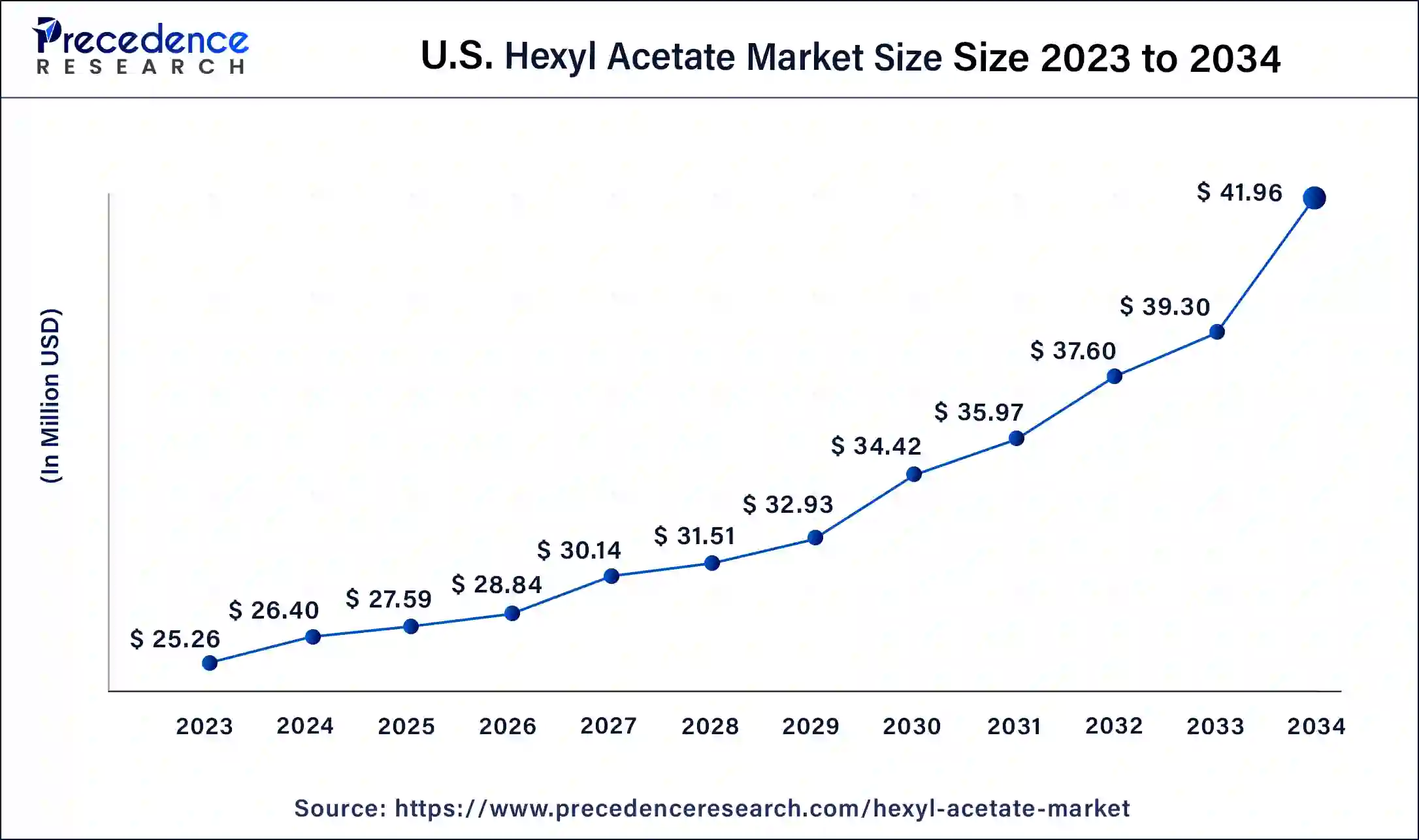
North America held the largest share in the hexyl acetate market in 2023. Numerous variables, such as the compound's applications and the growth patterns of the sectors that use it, are driving the North American hexyl acetate market. Hexyl acetate is an ester that is frequently used in flavorings and scents, making it important in industries including food and beverage, cosmetics, and personal care. Because of its pleasant fruity odor, hexyl acetate is frequently utilized in the manufacture of perfumes, colognes, and other personal care products. Additionally, hexyl acetate is utilized as a solvent in the production of coatings, paints, and cleaning products. In the food and personal care sectors, consumers are becoming more and more interested in natural and environmentally friendly components.
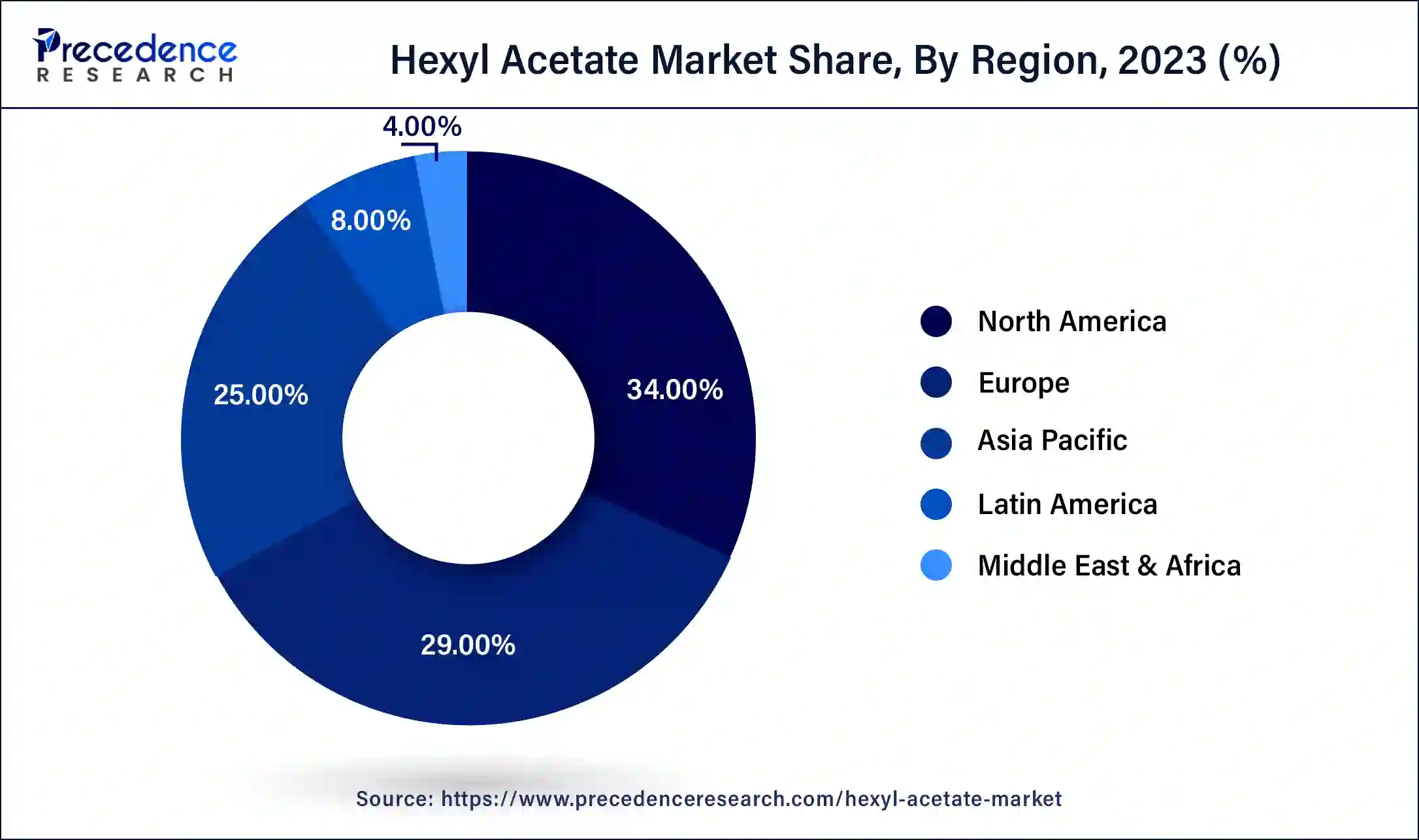
Asia Pacific is expected to host the fastest-growing hexyl acetate market during the forecast period. Hexyl acetate is a common aroma component found in cosmetics and personal hygiene items. Hexyl acetate is in high demand due to shifting consumer lifestyles and increased disposable incomes in Asia Pacific, which is driving up the cost of these products. Hexyl acetate has an application in the food and beverage sector as a flavoring ingredient. The market is predicted to rise as a result of this industry's explosive expansion in Asia Pacific, especially in developing nations like China and India. Asia Pacific is seeing rapid urbanization and infrastructure development, which is fueling a growth in building activities and, ultimately, a rise in the need for paints and coatings and hexyl acetate.
Hexyl acetate is a chemical molecule that is mostly utilized in the food business as a flavoring agent and in the cosmetics and personal care industries as a fragrance element. The food and beverage industry has a strong demand for hexyl acetate due to its widespread use as a food ingredient, particularly in fruit flavors like apple and banana. Because of its pleasing fruity scent, it is used in colognes, perfumes, and other personal care products, which is helping to expand the market for it. The hexyl acetate market sourced from natural sources is seeing growth due to rising consumer awareness and preference for natural ingredients in cosmetics and personal care products.
The use of hexyl acetate in pharmaceutical formulations is another area where it is found, broadening its market beyond conventional industries. Price fluctuations for raw materials, which are frequently derived from petrochemicals, can have an effect on pricing and production costs. The hexyl acetate market is anticipated to expand gradually due to rising demand from the food, cosmetics, and pharmaceutical sectors. Future developments in production technologies and sustainable sourcing practices will probably influence the market's structure. Global consumer preferences and regulatory frameworks, along with the product's numerous usages across multiple industries, support the overall market dynamics of hexyl acetate. Expanding consumer markets and growing use in the food and personal care sectors.
How is AI Revolutionizing the Chemical Processing Market
Artificial Intelligence is a powerful tool that can be harnessed by the chemical processing industry. AI is currently being used to automate tasks, provide insights into how different compounds react through accurate simulations and improve the overall manufacturing process. Chemical production is a complex process which poses several optimization challenges. AI significantly benefits the industry through improving efficiency and reducing costs incurred during the manufacturing process. AI is being used to design new chemical compounds and speed up analysis of chemical products. This also has several applications in the pharmaceutical industry where now a drug’s standard road to market has been cut down significantly.
| Report Coverage | Details |
| Market Size by 2034 | USD 161.08 Million |
| Market Size in 2023 | USD 99.05 Million |
| Market Size in 2024 | USD 103.53 Million |
| Market Growth Rate from 2024 to 2034 | CAGR of 4.52% |
| Largest Market | North America |
| Base Year | 2023 |
| Forecast Period | 2024 to 2034 |
| Segments Covered | Type, Application, and Regions |
| Regions Covered | North America, Europe, Asia-Pacific, Latin America and Middle East & Africa |
Rising disposable income
Customers are more inclined to spend money on products containing hexyl acetate when they have more discretionary cash. Because of its pleasant fruity odor, this chemical is commonly utilized in cosmetics, home cleansers, and personal care items. Higher discretionary earnings are commonly associated with a taste for upscale and premium goods, many of which include hexyl acetate due to its flavor and fragrance characteristics. This pattern encourages the hexyl acetate market expansion. In the food sector, hexyl acetate is used as a flavoring agent. The demand for hexyl acetate is driven by customers' tendency to buy more packaged and processed goods as their income rises. Growing disposable incomes are encouraging more people in emerging nations to buy home and personal care goods.
Health and safety concerns
For producers, employees, and customers in the hexyl acetate market, health and safety issues are vital. A solvent utilized in many different industries, hexyl acetate, has a number of health and safety concerns. Breathing in vapors of hexyl acetate can irritate the respiratory system, resulting in symptoms like wheezing, coughing, and dyspnea. Hexyl acetate can irritate skin and eyes when it comes into direct contact with it. There could be tearing, itching, and redness as symptoms. Hexyl acetate consumption might result in gastrointestinal problems such as nausea, vomiting, and pain in the abdomen. In extreme circumstances, it might have more harmful effects. Hexyl acetate Safety Data Sheets describing the risks, safe handling techniques, and emergency protocols must be supplied by suppliers and manufacturers.
Research and development
Because of its pleasant fruity odor, hexyl acetate is an organic chemical that is frequently utilized in the fragrance and flavor industries. It is also used in many other applications, including polymers, paints, coatings, and solvents. The goal of research is to create ecologically friendly and sustainable industrial techniques. This involves utilizing green chemistry methods and bio-based raw materials to lessen the negative environmental effects of hexyl acetate production. The goal of R&D is to develop novel mixtures and formulations that improve the sensory qualities of hexyl acetate in food flavorings and perfumes. Research and development efforts are concentrated on the application of the hexyl acetate market in the manufacturing of polymers and plastics, examining its potential to enhance these materials' resilience to environmental influences, flexibility, and durability.
The catalyzed reactive distillation synthesis segment led the hexyl acetate market in 2023. Within the market, the catalyzed reactive distillation synthesis segment denotes a particular process for producing hexyl acetate. This ester is frequently used in the fragrance and taste sectors, coatings, and solvents. Compared to conventional synthesis techniques, this approach can have a number of benefits since it integrates the reaction and distillation processes into a single apparatus. It lowers capital and operating expenses by eliminating the need for many pieces of equipment by combining separation and reaction into a single process. Because impurities are easier to separate, higher purity levels of hexyl acetate can be achieved through the continual removal of products.
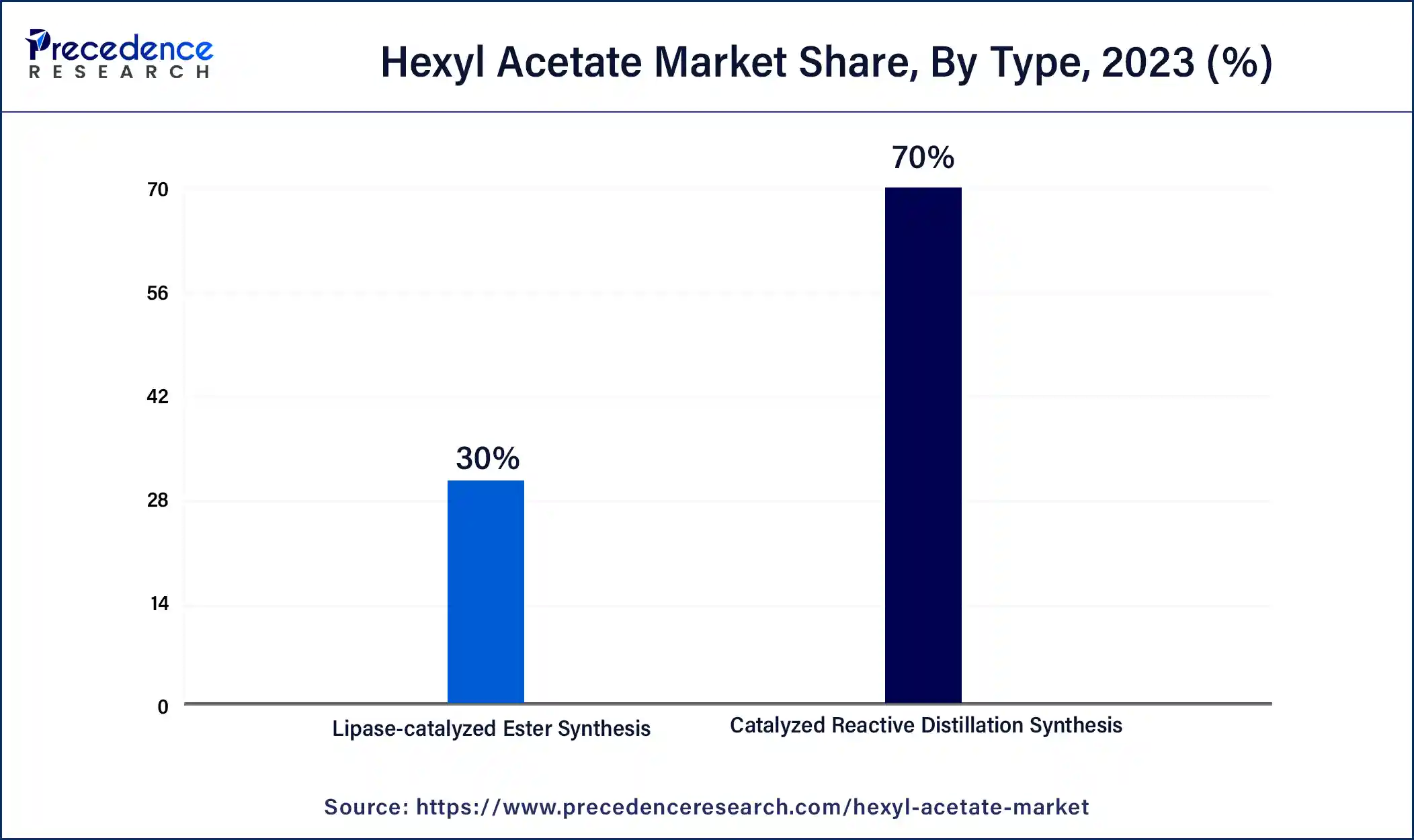
The lipase catalyzed ester synthesis segment is expected to grow at the fastest rate in the hexyl acetate market over the studied period. Lipase-catalyzed ester synthesis is a significant market segment for hexyl acetate because it is involved in the synthesis of hexyl acetate, a substance that is frequently utilized in tastes and perfumes. Using lipase enzymes to catalyze the esterification process between hexanol and acetic acid to make hexyl acetate is known as lipase-catalyzed ester synthesis. Because of its effectiveness and capacity to yield highly pure esters, this process is preferred. The food and beverage sector uses hexyl acetate extensively because of its pleasant, apple-like scent. For these uses, the ester's quality and purity are essential. The market for hexyl acetate is driven by the lipase-catalyzed ester synthesis segment due to the rising demand for high-purity esters in flavors, perfumes, and cosmetics.
The flavoring agent segment held the largest share of the hexyl acetate market in 2023. Because of its fruity, apple-like flavor profile, hexyl acetate is mostly used in the food and beverage industry, according to the hexyl acetate market's flavoring agent section. In order to improve or give a fruity taste, hexyl acetate is frequently employed as a flavoring in beverages, baked goods, confectionery, and other food products. Hexyl acetate is frequently used in taste formulations for goods, including pastries, candies, and beverages with fruit flavors. Consumer preferences for natural and enticing fruit flavors in a variety of food products impact the demand in this market. Hexyl acetate is one of the flavoring agents that must adhere to food safety standards and regulations in order to be used in consumable goods.
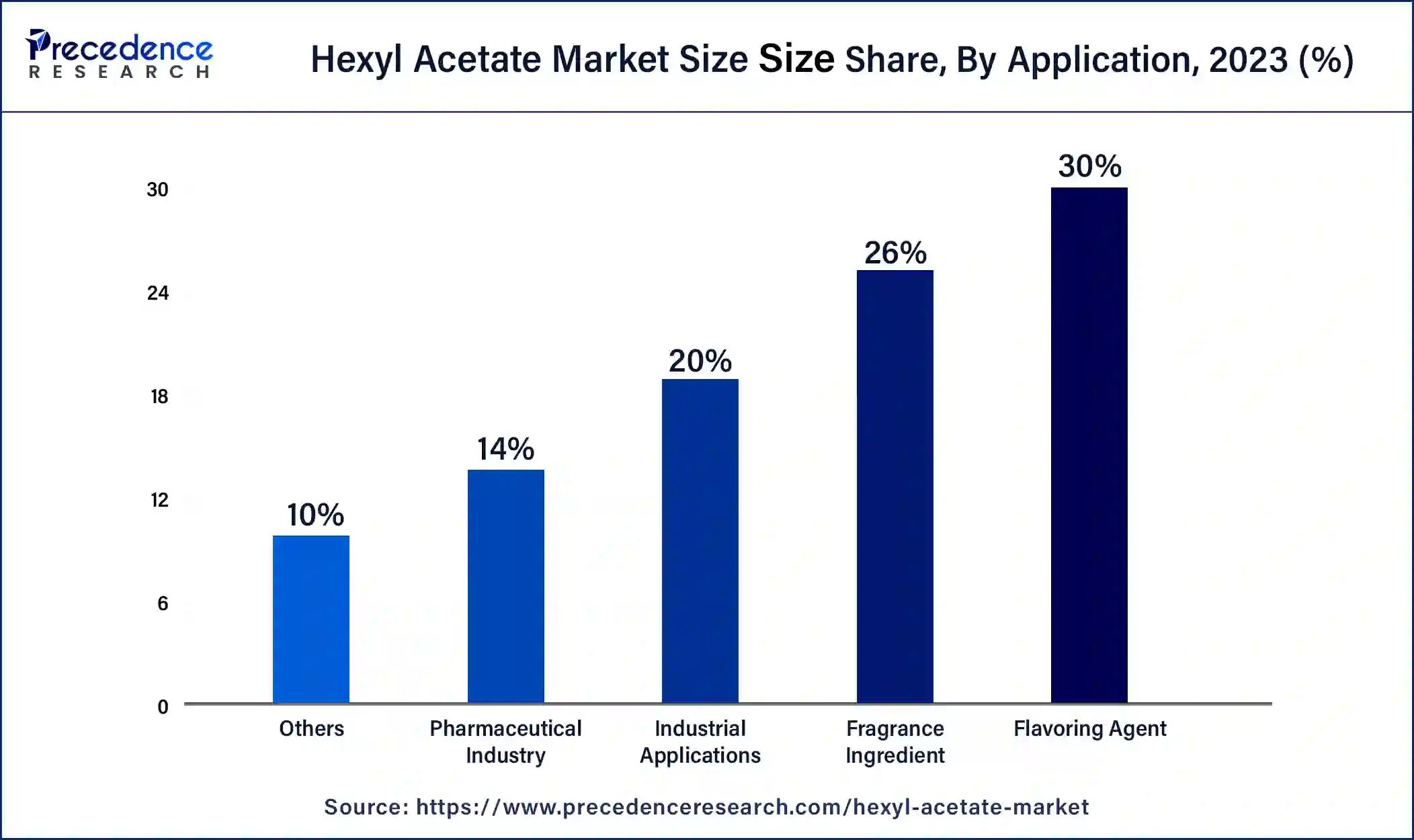
The fragrance ingredient segment is expected to grow at the fastest rate in the hexyl acetate market over the studied period. The category of scent ingredients is a noteworthy use. The fragrance industry frequently uses hexyl acetate because of its pleasant, apple-like aroma. This makes it a well-liked option for colognes, perfumes, and other scented goods. Hexyl acetate is used to make perfumes and other smells. It improves the product's overall scent profile by adding a crisp, fruity note. Growing consumer demand for natural and fresh scents in personal care products is driving the need for hexyl acetate in the fragrance industry. The rising demand for high-end and luxury perfumes, together with the growing personal care and cosmetics sectors, are factors driving the expansion of hexyl acetate in this market.
Segment Covered in the Report
By Type
By Application
By Geography
For inquiries regarding discounts, bulk purchases, or customization requests, please contact us at sales@precedenceresearch.com
No cookie-cutter, only authentic analysis – take the 1st step to become a Precedence Research client
January 2025
October 2024
October 2024